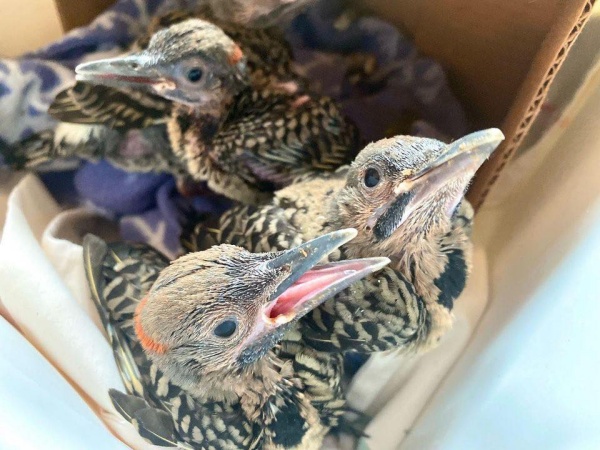New England Wildlife Center nursing orphaned flicker chics after tree falls down
“This family of flickers is growing by the day! Earlier this week the tree they were living in came down and left these four orphaned.
Two good friends of the center found them after hearing some very interesting noises coming from the toppled Oak. They were able to retrieve them from their knothole nest and safely secure them in a basket. They were even kind enough to hold a stakeout for us to see if mom was still in the area so that we could try to re-nest them.

New England Wildlife Center photo.
Sadly, mom did not return for the little ones, but they are now safely in our care. Our veterinary team gave them a full work-up and found them to be quite healthy, and quite hungry! They went through several plates of flicker food in the first sitting! These little guys will continue to eat several times an hour until they are ready to “fledge” and strike out on their own. When they are ready we’ll take them back to a nearby spot and release them ?
Northern flickers are part of the woodpecker family but rather than scaling up and down trees you will more commonly flush them out of a feeding spot on the ground. Rumor has it that they get their name because as they’re flying away from you the yellow color on the underside of their tail and wings moves up and down and looks like a flame flickering. We happen to think they look a bit more like pterodactyls at this age, but to each their own ?
This is just a friendly reminder to check freshly downed trees for creatures of all types! Birds like these flickers (and several species of local owls) make their homes in cavities inside the tree, and may not be immediately visible at first glance.
A through VISUAL check (don’t want anyone losing a finger) of the tree cavities can help ensure no animals are hurt in the clearing process. Sometimes these animals will continue to use the original nest after the tree has fallen, so if you come across an interior nest and do not spy any apparent injuries to the young, stepping back to observe for the parents is a good first step. You can always call us for advice as well!” -New England Wildlife Center.